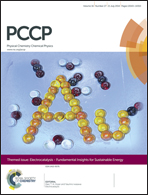Structure of the Pb2+–deprotonated dGMP complex in the gas phase: a combined MS-MS/IRMPD spectroscopy/ion mobility study†
Abstract
The structure of the Pb2+–deprotonated 2′-deoxyguanosine-5′-monophosphate (dGMP) complex, generated in the gas phase by electrospray ionization, was examined by combining tandem mass spectrometry, mid-infrared multiple-photon dissociation (IRMPD) spectroscopy and ion mobility. In the gas phase, the main binding site of Pb2+ onto deprotonated dGMP is the deprotonated phosphate group, but the question is whether an additional stabilization of the metallic complex can occur via participation of the carbonyl group of guanine. Such macrochelates indeed correspond to the most stable structures according to theoretical calculations. A multiplexed experimental approach was used to characterize the gas-phase conformation of the metallic complex and hence determine the binding mode of Pb2+ with [dGMP]−. MS/MS analysis, observation of characteristic bands by IRMPD spectroscopy, and measurement of the ion mobility collision cross section suggest that gaseous [Pb(dGMP)-H]+ complexes adopt a macrochelate folded structure, which consequently differs strongly from the zwitterionic forms postulated in solution from potentiometric studies.


 Please wait while we load your content...
Please wait while we load your content...